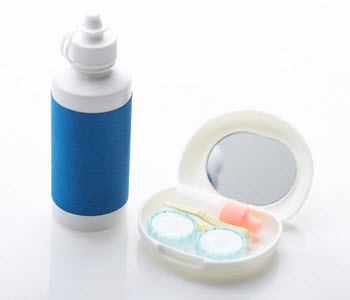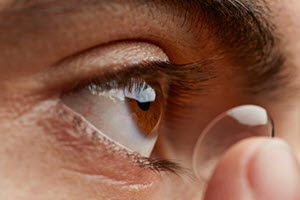It is not a good idea to buy and use contact lenses (CL:s) without a contact lens prescription. This is true even for plano (non-corrective) CL:s that are worn for cosmetic reasons. A lens prescription isn’t just to get the correction right, it is also about getting a CL that fits your individual eye. CL:s that do not fit correctly can cause a lot of eye problems, even after just a few hours of usage.
When your CL prescription is a year old, it is time to get a new one – even if you haven’t noticed any changes in vision. During the eye exam, the eye care professional will check the health of your eyes and notice early warning signs. Since there are certain medical conditions associated with CL wear, it is important to have your eyes checked once a year. Finding out early, even before you notice any symptoms from the eye, makes it much easier to prevent a problem from turning into a major problem.
To make it easier for you to understand what your contact lens prescription is saying about your eyes, we have collected some of the most commonly used terms here below.
 Diopter
Diopter
Diopter (also spelled dioptre) is a unit of measurement of the optical power of a lens, which is equal to the reciprocal of the focal length measured in meters (that is, 1/metres). It is thus a reciprocal length.
On a CL prescription, things such as how nearsighted / farsighted / astigmatic the eye is will be measured in diopters.
When diopter needs to be abbreviated on the CL prescription, it is usually abbreviated to the letter D.
The total optical power of a relaxed and healthy human eye is roughly 60 diopters. Of these 60 diopters, the cornea accounts for roughly 40 diopters and the crystalline lens for roughly 20 diopters.
OD & OS
It is quite unusual for a human to have identically shaped eyes in need of identically shaped CL:s and identical visual correction. Because of this, your CL prescription will contain separate information for your left eye and your right eye, respectively.
The information filled in after the abbreviation OD is the info concerning your right eye. OD = ocolus dexter = right eye.
The information filled in after the abbreviation OS is the info concerning your left eye. OS = ocolus sinister = left eye.
If you do have identical eyes, the eye care professional can write OU on the prescription. OU = oculus uterque = both eyes. This means that you have the same prescription for both eyes.
Diameter (DIA)
After the abbreviation DIA on your CL prescription, your eye care professional will write down which contact lens diameter that is ideal for you. This is normally measured in millimeters.
 Base curve (BC)
Base curve (BC)
After the abbreviation BC, your eye care professional will write down which curvature the inside of the CL must have to fit your eye properly. This is normally measured in millimeters. The lower the number, the steeper the curvature.
Using a CL with the wrong base curve means using a CL that doesn’t follow the shape of your eye. Unsurprisingly, this can cause eye irritation and complications.
PWR or SPH
The number written by your eye care professional after the abbreviation PWR or SPH denotes the corrective strength required for that eye. PWR is an abbreviation of power, while SPH is an abbreviation of sphere.
The unit of measurement is diopter.
Example: Your CL prescription says “OD PWR -2.50”. This means that you need correction for 2.50 diopters of myopia on your right eye.
A negative number denotes a correction for myopia (nearsightedness) while a positive number denotes a correction for hyperopia (farsightedness).
N.B! On some CL prescriptions, the eye care professional will simply write down the visual correction needed right after OD, OS or OU, without also adding the abbreviation PWR or SPH.
Plano (PL)
A plano CL is a CL that does not give any visual correction. A lot of people wear plano CL:s for cosmetic reasons, e.g. to display another eye color or to hide scars in the eye. The PWR or SPH of a plano CL is 0.00.
Example:
OD PWR -2.50
OS PWR 0.00
This means that you need 2.50 diopters of correction for myopia on your right eye, but no correction at all for myopia or hyperopia for your left eye.
Cylinder (CYL) & AXIS
CL:s can be used to correct astigmatism. This is true for both rigid CL:s and (toric) soft CL:s.
If you will be using CL:s to correct for astigmatism, your CL prescription will include one value for Cylinder (CYL) and one value for AXIS.
CYL shows how astigmatic the eye is. CYL is measured in diopters.
AXIS shows how slanted the cylinder should be. This measurement is measured in degrees. (Number of degrees required to bend the light to correct the astigmatism.)
Add power (ADD)
This field on your CL prescription will be filled in if you are getting bifocal CL:s. Bifocal CL:s have two prescriptions in the same lens. The number filled in after ADD will show how much the lens needs to be adjusted, measured in diopters.
This article was last updated on: April 24, 2016

